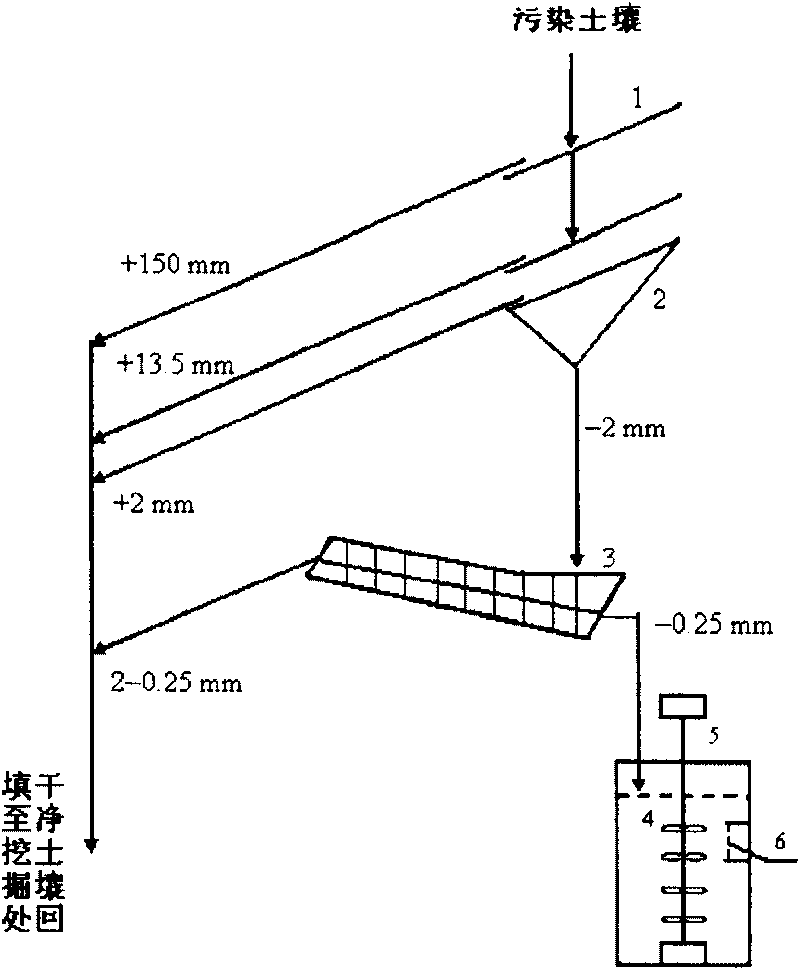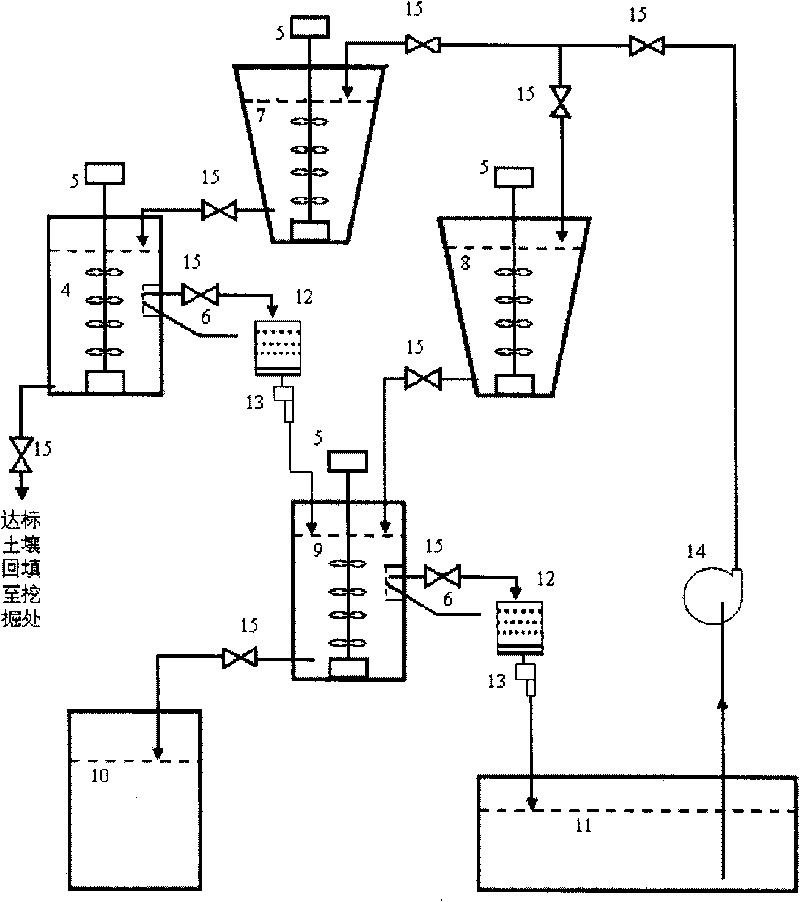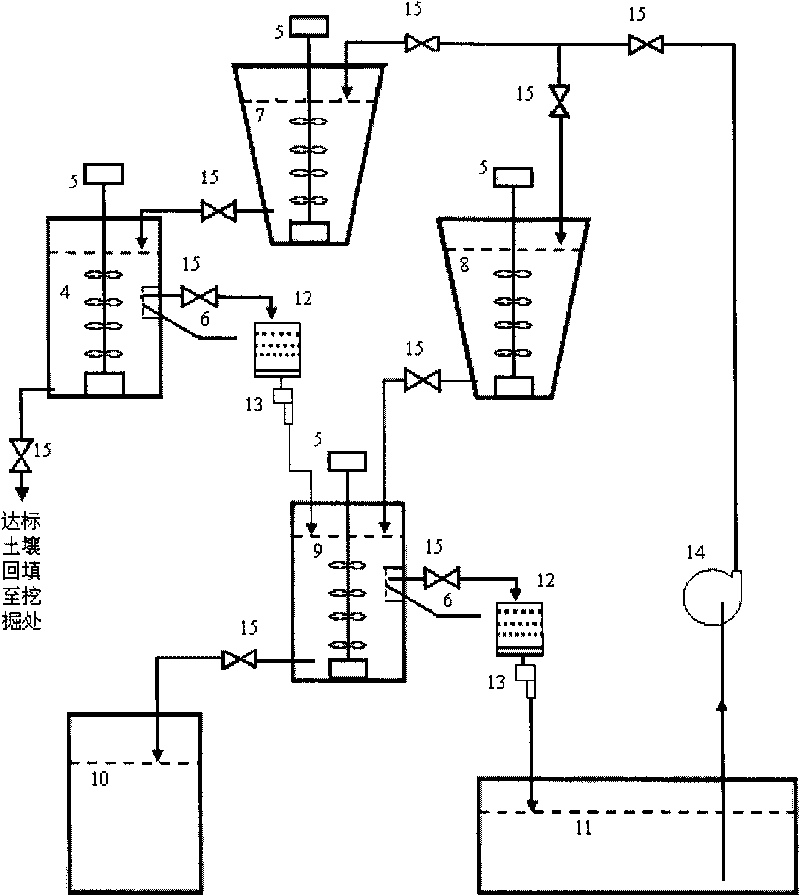Method for treating radioactive cesium-137 polluted soil
A technology of polluted soil and treatment method, which is applied in the field of radioactive cesium slightly polluted soil, and can solve the problems of limited efficiency of physical decontamination, secondary pollution, etc.
- Summary
- Abstract
- Description
- Claims
- Application Information
AI Technical Summary
Problems solved by technology
Method used
Image
Examples
Embodiment 1
[0015] 1) Activated acidophilic Thiobacillus ferrooxidans (A.f bacteria): the activation medium formula is 0.40g KCl, 0.50g MgSO 4 ·7H 2 O, 0.10g Ca(NO 3 ) 2 4H 2 O, 0.01g CuSO 4 ·5H 2 O, 0.10g KH 2 PO 4 , 0.40g (NH 4 ) 2 Fe(SO 4 ) 2 ·6H 2 O, 990 mL tap water. Adjust the pH value to 2.0-2.3, sterilize under 0.1MPa steam pressure for 30min, and cool down. Then 10 mL of 30% FeSO 4 Separately filter sterilize and add to the above solution which has been sterilized. Take 150mL of activation medium in a 500mL Erlenmeyer flask, draw 20mL of the active bacteria liquid of A.f bacteria and add it to the activation medium, and then place it in a constant temperature shaker at 28-32°C for shaking culture for 14 days. Gradually reduce the amount of inoculum in the same way and carry out transfer culture. After repeated transfer culture and filtration, the active bacterial liquid of A.f bacteria (microbial biomass is 10 ~ 15g / L) is obtained.
[0016] 2) Activated sulfate-re...
Embodiment 2
[0028] 1) Activation of acidophilic Thiobacillus ferrooxidans (A.f bacteria): Same as Example 1.
[0029] 2) Activation of sulfate-reducing bacteria (SRB bacteria): same as in Example 1.
[0030] 3) Preparation of reaction medium rich in iron and sulfur: (NH 4 ) 2 SO 4 2.50g, KH 2 PO 4 2.50g, MgSO 4 ·7H 2 O 0.50g, CaCl 2 2H 2 O 0.25g, FeSO 4 ·7H 2 O 8.20g, sulfur powder 4.65g, pyrite powder 4.55g, add tap water to 1000mL and mix well.
[0031] 4) Volume reduction by sieving cesium-137 slightly polluted soil: same as in Example 1.
[0032] 5) In the microbial dissolution-promoting reactor (4), cesium-137 micro-polluted soil is dropped into by the amount of 105.26g soil / 100mLA. The reaction culture medium of sulfur is put into the microbiological solubilization reactor (4), ventilated and stirred at 25-35° C. for 10-14 days (120 r / m), and sampled and analyzed.
[0033] 6) Backfill the soil with cesium-137 content up to the standard in the sedimentation part of the m...
Embodiment 3
[0039] 1) Activation of acidophilic Thiobacillus ferrooxidans (A.f bacteria): Same as Example 1.
[0040] 2) Activation of sulfate-reducing bacteria (SRB bacteria): same as in Example 1.
[0041] 3) Preparation of reaction medium rich in iron and sulfur: (NH 4 ) 2 SO 4 2.50g, KH 2 PO 4 2.50g, MgSO 4 ·7H 2 O 0.50g, CaCl 2 2H 2 O 0.25g, FeSO 4 ·7H 2 O 6.80g, sulfur powder 3.45g, pyrite powder 3.85g, add tap water to 1000mL and mix well.
[0042] 4) Volume reduction by sieving cesium-137 slightly polluted soil: same as in Example 1.
[0043] 5) In the microbial dissolution-promoting reactor (4), cesium-137 slightly polluted soil is dropped into by the amount of 111.11g soil / 100mLA. The reaction culture medium of sulfur is put into the microbiological solubilization reactor (4), ventilated and stirred at 25-35° C. for 10-14 days (120 r / m), and sampled and analyzed.
[0044] 6) Backfill the cesium-137 content of the sedimentation part in the microbe solubilization reac...
PUM
| Property | Measurement | Unit |
|---|---|---|
| particle diameter | aaaaa | aaaaa |
Abstract
Description
Claims
Application Information
 Login to View More
Login to View More - R&D
- Intellectual Property
- Life Sciences
- Materials
- Tech Scout
- Unparalleled Data Quality
- Higher Quality Content
- 60% Fewer Hallucinations
Browse by: Latest US Patents, China's latest patents, Technical Efficacy Thesaurus, Application Domain, Technology Topic, Popular Technical Reports.
© 2025 PatSnap. All rights reserved.Legal|Privacy policy|Modern Slavery Act Transparency Statement|Sitemap|About US| Contact US: help@patsnap.com



